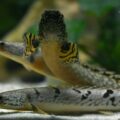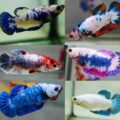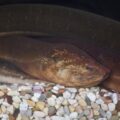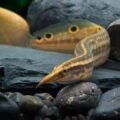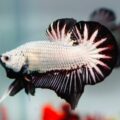This practical guide on managing rubber eel care in an aquarium for a maximized lifespan includes tips on correct species identification, tank setup, feeding, and much more!

Rubber Eel: Aquatic Caecilian with Fascinating Biology
Have you ever seen Typhlonectes natans, also called Rubber Eel, a limbless caecilian species that looks like an eel but isn’t quite a true eel?
In this rubber eel overview, you’ll learn about the air-breathing amphibian, which has an interesting rubbery appearance and a shy personality.
As a viviparous amphibian from the rivers and streams of South America and the Caribbean, aquatic caecilian care in a controlled environment requires expertise.
So, if you’re intrigued and ready to take on the challenge, here’s a Typhlonectes natans intro to prepare you.
Author’s Note: Check out our post on The 13 Freshwater Aquarium Eels That Can be Kept as Pets for even more eels!
Natural Habitat & Adaptations

Typhlonectes natans’ natural range is in the slow rivers and streams of South America, specifically Venezuela and the boundary close to Trinidad and Tobago.
This natural rubber eel habitat is often swampy with vegetation, so it enjoys soft mud and plants in aquariums. Like many species from South American aquatic habitats, Rubber Eels can stay submerged for long periods, so they need oxygenated tanks to survive.
Before we get to practical ways to recreate a caecilian environment, let’s identify the Rubber Eel.
Physical Features & Size
You can use unique physical features and traits to identify rubber eel species.

Distinct aquatic caecilian physical traits include the following:
- A dark-gray, smooth skin
- A snake-like body with no limbs
- Tiny eyes on the sides of their heads
At full length, an adult Rubber Eel stretches approximately between 18 and 22”. Beyond the obvious rubber eel appearance, you can also distinguish this species by its traits.
This species is viviparous, meaning it gives birth to live young without going through a cycle. It also bites when stressed, although that’s a rare occurrence.
Now, build an ideal tank setup based on these unique Typhlonectes features.
Aquarium Setup & Decorations

For your rubber eel tank setup, you’ll need:
- A tank
- PVC tubes
- Soft Substrate
- Decor
- Filter
- Water
Tank Size and Layout
A long container with an average of 30 – 40 gallons of water per single adult is the best tank for rubber eel species.
Adding smooth rocks, driftwood, and PVC hides for aquatic pets like these makes them feel safe and keeps them from escaping.
Also, add a secure lid for an escape-proof caecilian habitat.
Substrate
Cover the floor with a soft, sandy substrate that’s gentle on the skin as your Rubber eel burrows during the day.
Decor

Because Rubber eels are escape artists who need surface air access, your aquarium decor must be escape-proof without suffocating them. Secure the tank with a lid with clips or a heavy decor piece for reinforcement.
Also, add floating plants to keep the surface covered while the Rubber eel swims up for air.
Water Conditions & Filtration

Penn-Plax Cascade All-in-One Aquarium Canister Filter
Found On Amazon
After setting up your tank structure and decor, it’s time to fill it with water in the ideal conditions. From water parameters to filtration type for optimal quality, here are some soft water aquarium care tips:
Water Condition
Dechlorinate the water or use tap water for your Rubber eel aquarium. Ideal rubber eel water parameters are soft, low-current, and cool temperatures like the Venezuelan rivers.
| Temperature | 75–82°F |
| pH | 6.5 – 7.5 |
| Hardness | soft | 12 – 25 dGH |
Typhlonectes natans care also includes keeping the water stable and clean all the time.
Filtration Type and Maintenance
Rubber eels are a sensitive species, so you’d need a good filtration system to keep their environment clean. Set the current to a low level using a sponge filter for a small to medium tank of 40 – 60 gallons and a canister filter for big to large tanks.
Author’s Note: Checkout the post on The 7 Best Aquarium Canister Filters Reviewed (2024) for an in-depth guide on choosing the right filter for your aquarium!
Change 25 – 50% of the water weekly, and always clean leftover food after feeding. These rubber eel care tips ensure a pristine environment for good health.
Diet & Feeding

Your next thought would be on what to feed Typhlonectes outside their natural environment. First, you must understand their feeding nature, then preferences, and timing.
Follow this rubber eel feeding guide if you’re a beginner without a clue on what to do.
- Staples: Live foods like Earthworms, frozen bloodworms, and shrimps.
- Supplements: Carnivore Sinking Pellets
Although rubber eels can tolerate pellets, they should be treats and not daily meals. This species thrives better on meaty diets and eats at night.
With these caecilian diet tips, you can ensure your rubber eel grows in good health with strengthened immunity.
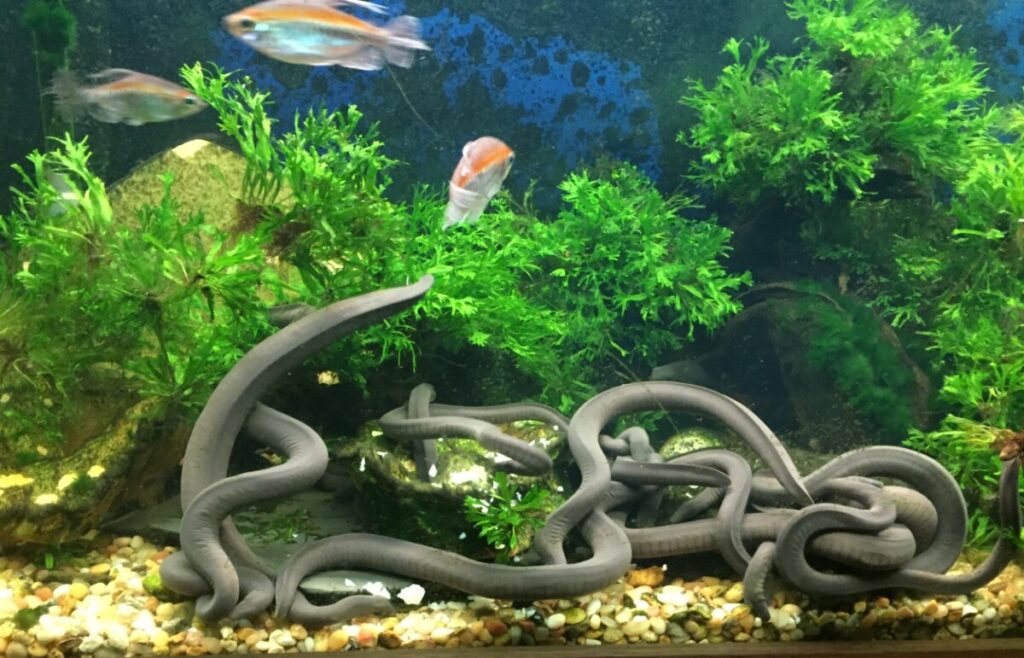
Are you considering keeping rubber eels with other fish species? Would you like to know more about Typhlonectes temperament and how they interact with other tank mates? Don’t do it.
Despite being a peaceful aquatic caecilian, the Rubber eel is best kept in a species-only tank. If you keep them with other species, especially smaller fish, they’ll eat them. The rubber eel compatibility mostly works within its species, with a few exceptions for large fish,
- larger tetras
- larger barbs
- Chinese Algae Eater
- Common Pleco
Note: It is highly recommended to not keep them in community tanks!
You can keep three to five Rubber eels in a 20-gallon tank comfortably depending on their activity levels. However, they can only thrive in communities of larger tanks holding 100 gallons or more though.
Health Risks & Lifespan
Providing ideal living conditions, adequate diet, and tank mates is more than 75% of rubber eel health care, but there’s still more work to do. With proper amphibian health management, this species can live between 5 and 15+ more years.
Here are some more Typhlonectes care tips to help manage their sensitivity to water changes and ensure you maximize the lifespan of rubber eels:
- Minimize or avoid handling
- Wash your hands before and after handling them if you just touch them
- Set gentle water currents
- Keep subtropical water temperatures
Doing these will reduce the risk of water-related diseases and infections for your pets.
Breeding & Special Traits

Breeding rare aquatic pets like Rubber eels in captivity is often rare and challenging. It doesn’t help that there’s limited rubber eel breeding info on the internet and in libraries.
Typhlonectes’ reproduction is different from most amphibians because they are viviparous, meaning they give birth to live young instead of laying eggs.
However, from common knowledge of this species being livebearers, you can adopt tested and trusted viviparous amphibian care practices. And with some luck your pets might breed. If they do please share your results in the comments section below.
Prep the tank using the parameters above and serve the young Rubber eels the same food as the adults.
Conclusion: Is the Rubber Eel Right for You?
With this comprehensive rubber eel pet advice, you can confidently venture into keeping Typhlonectes. You can scroll up for details, but here’s a summary of beginner caecilian care, from its biology to niche needs.
- Secure tank with lids
- Keep the water cool
- Feed them at night with live food
- Make your tank species-only
Author’s Note: Here’s a bonus since you have made it this far! Check out our post on 7 Beginner-Friendly Amphibians!
Because niche aquarium pet care can be complex and challenging, it’s best left to specialist keepers with the skills and capacity to give these pets a great life.



